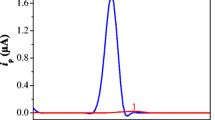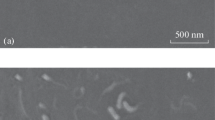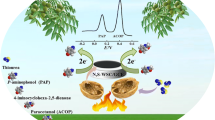Abstract
In the present work, a glassy carbon electrode was modified with carboxyl functionalized multi-walled carbon nanotubes (f-MWCNTs) to investigate the electrochemical behavior of naproxen (NAP) and the adsorbed NAP oxidation products (NAPop) for the first time. Cyclic and linear sweep voltammetry techniques were used for the electrochemical investigation of NAP and the adsorbed NAPop. The results showed that the mechanisms of the oxidation reaction of NAP and the redox reaction of the adsorbed NAPop were irreversible and reversible surface-controlled processes, respectively. Then, an indirect method was applied for the determination of NAP with a focus on the adsorbed NAPop. Programmed linear sweep voltammetry (LSV) was performed, and two linear relationships were observed between the peak current intensity of LSV responses of the adsorbed NAPop and the concentration of NAP in the range of 0.0–30.0 µM and 30.0–250.0 µM. The limit of detection and limit of quantification for NAP determination based on S/N = 3 and S/N = 10 were calculated to be 2.0 and 6.8 µM, respectively. The effect of the presence of some potent interfering compounds was examined, and the developed method was applied for the determination of NAP in tap water and NAP tablet samples with satisfactory results.







Similar content being viewed by others
References
Díaz E, Stożek S, Patiño Y, Ordóñez S (2019) Electrochemical degradation of naproxen from water by anodic oxidation with multiwall carbon nanotubes glassy carbon electrode. Water Sci Technol 79:480–488
Hung C-M, Huang C, Chen S-K, Chen C-W, Dong C-D (2020) Electrochemical analysis of naproxen in water using poly (L-serine)-modified glassy carbon electrode. Chemosphere 254:126686
Hendawy HA, Salem WM, Abd-Elmonem MS, Khaled E (2019) Nanomaterial-based carbon paste electrodes for voltammetric determination of naproxen in presence of its degradation products. J Anal Methods Chem 2019:5381031
Kanagasabapathy M, Sekar R (2019) Chronopotentiometric/chronoamperometric transient analysis of naproxen via electrochemically synthesized nano spinel ZnFe2O4 films. J Electroanal Chem 832:59–68
Kalambate PK, Noiphung J, Rodthongkum N, Larpant N, Thirabowonkitphithan P, Rojanarata T, Hasan M, Huang Y, Laiwattanapaisal W (2021) Nanomaterials-based electrochemical sensors and biosensors for the detection of non-steroidal anti-inflammatory drugs. TrAC Trends Anal Chem 143:116403
Mohammadi Nodeh MK, Radfard M, Zardari LA, Rashidi Nodeh H (2018) Enhanced removal of naproxen from wastewater using silica magnetic nanoparticles decorated onto graphene oxide; parametric and equilibrium study. Sep Sci Technol 53:2476–2485
Kondori T, Tajik S, Akbarzadeh-T N, Beitollahi H, Graiff C, Jang HW, Shokouhimehr M (2021) Synthesis and characterization of bipyridine cobalt (II) complex modified graphite screen printed electrode: an electrochemical sensor for simultaneous detection of acetaminophen and naproxen. RSC Adv 11:3049–3057
Tarahomi S, Rounaghi GH, Daneshvar L (2019) A novel disposable sensor based on gold digital versatile disc chip modified with graphene oxide decorated with Ag nanoparticles/β-cyclodextrin for voltammetric measurement of naproxen. Sens Actuators B: Chem 286:445–450
Monser L, Darghouth F (2003) Simultaneous determination of naproxen and related compounds by HPLC using porous graphitic carbon column. J Pharm Biomed Anal 32:1087–1092
Pyka A, Wiatr E, Kwiska K, Gurak D (2011) Validation thin layer chromatography for the determination of naproxen in tablets and comparison with a pharmacopeil method. J Liq Chromatogr Related Technol 34:829–847
Kormosh Z, Kormosh N, Bokhan Y, Gorbatyuk N, Kotsan I, Suprunovich S, Parchenko V, Savchuk T, Korolchuk S (2021) Potentiometric sensor for naproxen determination. Pharm Chem J 55:97–99
Khan IU, Aman T, Ashraf A, Kazi AA (1999) Spectrophotometric determination of naproxen in pure and pharmaceutical preparations. Anal Lett 32:2035–2050
Damiani P, Bearzotti M, Cabezón MA (2002) Spectrofluorometric determination of naproxen in tablets. J Pharm Biomed Anal 29:229–238
Du J, Li D, Lu J (2010) Chemiluminescence determination of naproxen based on europium (III)-sensitized KIO4–H2O2 reaction. Luminescence 25:76–80
Preinerstorfer B, Lämmerhofer M, Lindner W (2009) Advances in enantioselective separations using electromigration capillary techniques. Electrophoresis 30:100–132
Aguilar-Lira G, Romero GÁ, Rojas-Hernández A, Páez-Hernández M, Rodríguez-Ávila J, Romero-Romo M (2014) Voltammetric analysis of naproxen in graphite electrodes and its determination in pharmaceutical samples. Electroanalysis 26:1573–1581
Pandey H, Khare P, Singh S, Singh SP (2020) Carbon nanomaterials integrated molecularly imprinted polymers for biological sample analysis: a critical review. Mater Chem Phys 239:121966
Guo L, Huang Y, Zhang Q, Chen C, Guo D, Chen Y, Fu Y (2014) Electrochemical sensing for naproxen enantiomers using biofunctionalized reduced graphene oxide nanosheets. J Electrochem Soc 161:B70
Sarhangzadeh K (2015) Application of multi wall carbon nanotube-graphene hybrid for voltammetric determination of naproxen. J Iran Chem Soc 12:2133–2140
Adhoum N, Monser L, Toumi M, Boujlel K (2003) Determination of naproxen in pharmaceuticals by differential pulse voltammetry at a platinum electrode. Anal Chim Acta 495:69–75
Afzali F, Rounaghi G, Zavar MHA, Ashraf N (2015) Supramolecular β-cyclodextrin/multi-walled carbon nanotube paste electrode for amperometric detection of naproxen. J Electrochem Soc 163:B56
do Prado TM, Badaró CC, Machado RG, Fadini PS, Fatibello-Filho O, Moraes FC, (2020) Using bismuth vanadate/copper oxide nanocomposite as photoelectrochemical sensor for naproxen determination in sewage. Electroanalysis 32:1930–1937
Fonseca WT, Santos RF, Alves JN, Ribeiro SD, Takeuchi RM, Santos AL, Assunção RM, Filho GR, Muñoz RA (2015) Square wave voltammetry as analytical tool for real time study of controlled naproxen releasing from cellulose derivative materials. Electroanalysis 27:1847–1854
Hung C-M, Huang C-P, Chen C-W, Dong C-D (2022) A poly-(L-serine)/reduced graphene oxide-Nafion supported on glassy carbon (PLS/rGO-Nafion/GCE) electrode for the detection of naproxen in aqueous solutions. Environ Sci Pollut Res 29:12450–12461
Suryanarayanan V, Zhang Y, Yoshihara S, Shirakashi T (2005) Voltammetric assay of naproxen in pharmaceutical formulations using boron-doped diamond electrode. Electroanalysis 17:925–932
Tashkhourian J, Hemmateenejad B, Beigizadeh H, Hosseini-Sarvari M, Razmi Z (2014) ZnO nanoparticles and multiwalled carbon nanotubes modified carbon paste electrode for determination of naproxen using electrochemical techniques. J Electroanal Chem 714:103–108
Aguilar-Lira G, Rojas-Hernández A, Rodriguez J, Páez-Hernández M, Álvarez-Romero G (2020) Optimized quantification of naproxen based on DPV and a multiwalled MWCNT-carbon paste electrode. J Electrochem Soc 167:166510
Kooshki M, Abdollahi H, Bozorgzadeh S, Haghighi B (2011) Second-order data obtained from differential pulse voltammetry: determination of tryptophan at a gold nanoparticles decorated multiwalled carbon nanotube modified glassy carbon electrode. Electrochim Acta 56:8618–8624
Haghighi B, Hamidi H, Gorton L (2010) Formation of a robust and stable film comprising ionic liquid and polyoxometalate on glassy carbon electrode modified with multiwalled carbon nanotubes: toward sensitive and fast detection of hydrogen peroxide and iodate. Electrochim Acta 55:4750–4757
Arulraj AD, Sundaram E, Vasantha VS, Neppolian B (2018) Polypyrrole with a functionalized multi-walled carbon nanotube hybrid nanocomposite: a new and efficient nitrite sensor. New J Chem 42:3748–3757
Sudha V, Kumar SMS, Thangamuthu R (2018) Simultaneous electrochemical sensing of sulphite and nitrite on acid-functionalized multi-walled carbon nanotubes modified electrodes. J Alloys Compd 749:990–999
Mekassa B, Tessema M, Chandravanshi BS (2017) Simultaneous determination of caffeine and theophylline using square wave voltammetry at poly (L-aspartic acid)/functionalized multi-walled carbon nanotubes composite modified electrode. Sens Biosens Res 16:46–54
Blanco E, Foster CW, Cumba LR, Do Carmo DR, Banks CE (2016) Can solvent induced surface modifications applied to screen-printed platforms enhance their electroanalytical performance? Analyst 141:2783–2790
Hu L, Peng X, Huo K, Chen R, Fu J, Li Y, Lee LYS, Wong K-Y, Chu PK (2016) Dominant factors governing the electron transfer kinetics and electrochemical biosensing properties of carbon nanofiber arrays. ACS Appl Mater Interfaces 8:28872–28879
Swain GM (2007) Solid electrode materials: pretreatment and activation. In: Handbook of electrochemistry. Elsevier pp 111–153
Cumba LR, Foster CW, Brownson DA, Smith JP, Iniesta J, Thakur B, Do Carmo DR, Banks CE (2016) Can the mechanical activation (polishing) of screen-printed electrodes enhance their electroanalytical response? Analyst 141:2791–2799
Wang H, Sayed SY, Luber EJ, Olsen BC, Shirurkar SM, Venkatakrishnan S, Tefashe UM, Farquhar AK, Smotkin ES, McCreery RL (2020) Redox flow batteries: how to determine electrochemical kinetic parameters. ACS Nano 14:2575–2584
Ashrafi H, Akhond M, Haghighi B (2022) Synthesis and application of heteroatom-doped graphite as the electrode material: influences of defect density and heteroatom on heterogeneous electron transfer rate. ACS Appl Electron Mater 4:4119–4128
Ferrari AG-M, Elbardisy HM, Silva V, Belal TS, Talaat W, Daabees HG, Banks CE, Brownson DA (2020) The influence of lateral flake size in graphene/graphite paste electrodes: an electroanalytical investigation. Anal Methods 12:2133–2142
Lavagnini I, Antiochia R, Magno F (2004) An extended method for the practical evaluation of the standard rate constant from cyclic voltammetric data. Electroanalysis 16:505–506
Al-Sherbini A-S, Bakr M, Ghoneim I, Saad M (2017) Exfoliation of graphene sheets via high energy wet milling of graphite in 2-ethylhexanol and kerosene. J Adv Res 8:209–215
Lima AP, Nunes GL, Franco RG, Mariano-Neto R, Oliveira GS, Richter EM, Nossol E, Munoz RAA (2021) Al2O3 microparticles immobilized on glassy-carbon electrode as catalytic sites for the electrochemical oxidation and high detectability of naproxen: experimental and simulation insights. J Electroanal Chem 882:114988–114997
Montes RH, Stefano JS, Richter EM, Munoz RA (2014) Exploring multiwalled carbon nanotubes for naproxen detection. Electroanalysis 26:1449–1453
Hamza M, Ammar S, Abdelhédi R (2011) Electrochemical oxidation of 1,3,5-trimethoxybenzene in aqueous solutions at gold oxide and lead dioxide electrodes. Electrochim Acta 56:3785–3789
Yang Y, Xia Y, Wei F, Teng G, Yao Y (2020) Preparation and characterization of hydrophobic stearic acid-Yb-PbO2 anode and its application on the electrochemical degradation of naproxen sodium. J Electroanal Chem 868:114191
Laviron E (1979) General expression of the linear potential sweep voltammogram in the case of diffusionless electrochemical systems. J Electroanal Chem Interfacial Electrochem 101:19–28
Funding
Shiraz University Research Council is appreciatively acknowledged by all authors of this article for financially supporting this research (grant no. 0GCU2M256692).
Author information
Authors and Affiliations
Corresponding author
Additional information
Publisher's Note
Springer Nature remains neutral with regard to jurisdictional claims in published maps and institutional affiliations.
Supplementary Information
Below is the link to the electronic supplementary material.
Rights and permissions
Springer Nature or its licensor (e.g. a society or other partner) holds exclusive rights to this article under a publishing agreement with the author(s) or other rightsholder(s); author self-archiving of the accepted manuscript version of this article is solely governed by the terms of such publishing agreement and applicable law.
About this article
Cite this article
Moghadam, A.M., Haghighi, B. Electrochemical characterization of naproxen and the adsorbed naproxen oxidation products at glassy carbon electrode modified with carboxyl functionalized multi-walled carbon nanotubes and introducing a new route for naproxen determination. J Solid State Electrochem 27, 2375–2385 (2023). https://doi.org/10.1007/s10008-023-05509-7
Received:
Revised:
Accepted:
Published:
Issue Date:
DOI: https://doi.org/10.1007/s10008-023-05509-7




